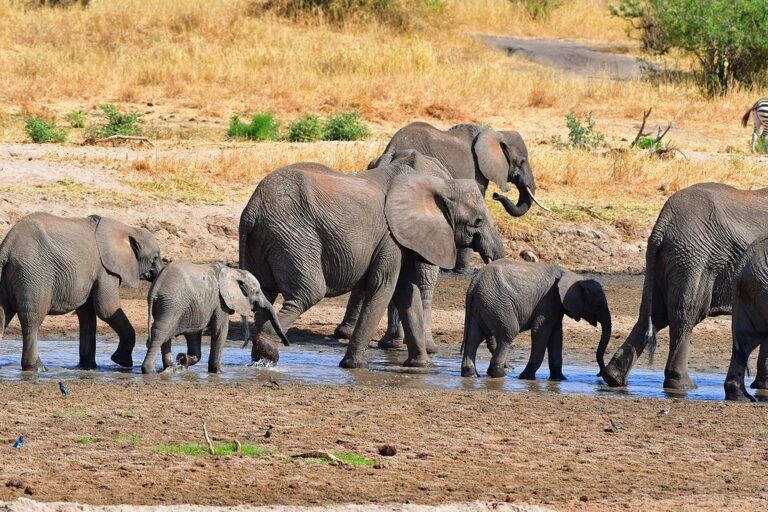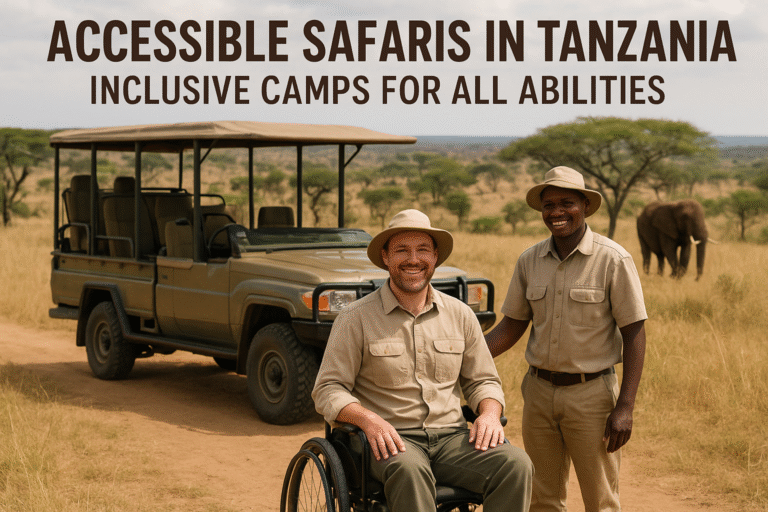Spotting Rare Animals in Tanzania: Top Camps for Unique Wildlife Encounters
Envision the hush of dawn breaking over the vast Serengeti plains, where a shadow flickers in the acacia’s shade—a fleeting glimpse of a black rhino, one of Africa’s most elusive ghosts. Or picture descending into the emerald bowl of Ngorongoro Crater, your binoculars trained on a herd of endangered wildebeest shadowed by a pride of lions, with the rare serval cat slinking through the tall grasses nearby. Tanzania isn’t just a safari destination; it’s a living ark for rare wildlife Tanzania, safeguarding some of the planet’s most threatened species amid breathtaking landscapes. At Tanzania Wild Camps, we curate intimate escapes that place you at the heart of these encounters, blending luxury tented camps with expert-guided forays into the wild. In this guide to endangered species Serengeti and spotting tips Ngorongoro lodges, we’ll uncover the icons worth seeking, spotlight our premier camps for optimal sightings, and share pro tips for your 2025 adventure. Whether you’re a seasoned tracker or a wide-eyed first-timer, prepare to connect with Tanzania’s hidden wonders—where every rustle holds a story.
As stewards of sustainable tourism, Tanzania Wild Camps champions authentic, low-impact experiences in Tanzania’s crown jewels: Serengeti National Park, Ngorongoro Conservation Area, and beyond. Our camps—Serengeti Safari Lodge, Serengeti Wild Camp, Ikoma Wild Camp, and Ngorongoro Wild Camp—offer more than beds under the stars; they provide front-row seats to biodiversity hotspots. With over 25% of Tanzania’s land protected as national parks and reserves, the country hosts an unparalleled density of wildlife, from the thundering Great Migration to solitary rarities like the black rhino. In 2025, as conservation efforts intensify amid climate pressures, these sightings feel more urgent—and rewarding—than ever. Our packages, starting at $350 per night full-board, ensure privacy in exclusive concessions, away from the masses, so you can savor the solitude of a leopard’s gaze or the thrill of a cheetah’s sprint.
Tanzania's Rare Wildlife: A Sanctuary for the Endangered

Tanzania’s ecosystems—from acacia-studded savannas to mist-veiled craters—nurture over 4 million wild animals, including 20% of Africa’s large mammals. But it’s the rare wildlife Tanzania that captivates: species teetering on the brink, their survival a testament to vigilant anti-poaching and habitat restoration. The Serengeti-Mara ecosystem alone supports the planet’s largest terrestrial migration, but dig deeper, and you’ll find gems like the African wild dog (painted wolf), with packs numbering under 7,000 continent-wide, or the pangolin, whose scales fetch black-market fortunes.
Conservation stats paint a hopeful picture: Tanzania’s rhino population has rebounded to over 200, thanks to fenced sanctuaries and community patrols. Yet challenges persist—habitat loss and human-wildlife conflict claim lives yearly. At Tanzania Wild Camps, we partner with local Maasai guardians, channeling guest fees into these initiatives. For 2025 travelers, this means guilt-free immersion: Spot a rhino, knowing your stay funds its protection.
Spotlight on Endangered Species in the Serengeti
The Serengeti, a UNESCO World Heritage Site spanning 14,750 square kilometers, is a crucible for rarity. Here, the endangered species Serengeti steal the show:
- Black Rhino (Critically Endangered): With fewer than 30 left in the ecosystem, these prehistoric tanks are the park’s rarest prize. Solitary and shy, they favor thorny thickets; spotting one feels like winning the lottery. Population: Global ~5,000; Tanzania’s share is a guarded secret.
- African Wild Dog: These pack hunters, down 80% in a century, prowl the southern plains. Vibrant coats and cooperative kills make sightings electric—watch a family of 10-20 take down an impala in synchronized fury.
- Pangolin and Aardvark: Nocturnal oddities, the scaly anteater and “earth pig” emerge at dusk, their burrows dotting the red earth. Rare by nature, they’re spotlighted on night drives.
- Serval and Caracal: Slender cats with satellite-dish ears, these ambush predators haunt grasslands, leaping 3 meters high for birds. Elusive but audible—their chirps echo at twilight.
The Great Migration amplifies drama: July-October, 1.5 million wildebeest cross rivers patrolled by Nile crocs, drawing predators en masse. But for rarities, venture off-trail with our guides, who track via radio collars and Maasai intel.
Top Camps for Serengeti Rare Wildlife Encounters

Our Serengeti portfolio transforms passive viewing into poetic proximity. Nestled in private concessions, these camps minimize disturbance while maximizing magic—think canvas walls whispering with hyena calls.
Serengeti Safari Lodge: Seronera’s Luxury Sentinel
Perched in the Seronera Tana Spring Area—Serengeti’s wildlife epicenter—this lodge is your launchpad for endangered species Serengeti quests. Fifteen spacious, self-contained tents boast private showers, en-suite toilets, and verandas framing waterholes where rhinos quench at dawn. Amenities shine: A gourmet restaurant blending Swahili spices with continental flair—savor ugali-stuffed impala post-drive. Evenings? Local BBQ under a canopy of stars, regaled by Maasai lore of spirit animals.
Activities: Dawn game drives target black rhinos in kopje hideouts; walking safaris reveal wild dog prints. Hot-air balloon rides ($550) offer aerial sweeps of serval haunts. Rates: $450/night full-board. Guest quote: “Spotted a rhino family from my tent—pure poetry.” For 2025, book our 4-night Migration Tracker package ($2,200), including rhino-tracking exclusivity.
Serengeti Wild Camp: Immersive Plains Poetry
In central Serengeti, this 10-tent haven elevates bush romance. Elevated decks overlook migration corridors, where pangolins shuffle by night. Eco-luxuries include solar-powered lanterns and open-air bush showers—rinse off the dust while elephants trumpet nearby. Dining: Communal fireside feasts of fresh tilapia from Lake Victoria.
Wildlife edge: Proximity to wild dog dens; guides lead bush breakfasts amid aardvark burrows. Add night drives for caracal spotlights. Rates: $400/night. Ideal for photographers—our 2025 Wild Dog Watch itinerary ($1,800/3 nights) guarantees pack pursuits.
Ikoma Wild Camp: Western Frontier for Solitary Seekers
Tucked in the Ikoma Open Area (western Serengeti), this camp chases the migration’s western wing. Eight tents blend into granite outcrops, offering seclusion for serval stalks. Amenities: Infinity plunge pools and massage salas for post-sighting soaks; family interconnecting units available.
Prime for rarities: Leopards drape from sausage trees; rare cheetah coalitions hunt here year-round. Activities: Guided bush walks unveil hidden springs teeming with crocs. Rates: $380/night. Extend with our 5-day Rare Cat Combo ($2,500), fusing Ikoma with Tarangire for panthera variety.
These camps embody our ethos: Award-winning (Best Tented Camp 2021) intimacy, where 10-15 guests foster genuine connections—with nature and each other.
Spotting Tips for Ngorongoro Lodges and Camps

Our Ngorongoro Wild Camp, rim-perched above Karatu, is your crater command center. Ten solar-powered tents with rim-view decks and en-suite bliss overlook the misty bowl. Amenities: Rimside spa and cultural dinners with Hadzabe hunter-gatherers.
Spotting Tips Ngorongoro Lodges:
- Dawn Descents: Enter at 6:30 AM—rhinos emerge from Lerai thickets. Pro: Cooler temps; fewer vehicles (cap at 6/car).
- Guide Wisdom: Our KWS-certified experts use telemetry for rhino tracks; scan hippo pools for golden cats at dusk.
- Patience Pays: Park at picnic sites—servals prowl edges. Binoculars essential; apps like iNaturalist ID calls.
- Seasonal Sync: Dry June-Oct for floor visibility; wet March-May greens hide but lure migrants. In 2025, align with full moons (e.g., July 21) for nocturnal wonders.
- Ethical Etiquette: Maintain 20m distance; no off-roading. Our camps fund crater patrols—your stay safeguards sightings.
Combine with a 3-day Crater Immersion ($1,200): Lodge stay, two descents, Maasai village visit.
Beyond the Big Five: Other Rare Gems and Broader Tips
Venture further: Tarangire’s python-haunted baobabs host reticulated pythons; Lake Manyara’s tree-climbing lions defy gravity. For primates, Mahale’s chimps (endangered, habituated troops) trek rainforests.
General spotting tips Ngorongoro lodges and beyond:
- Gear Up: Neutral khakis, sturdy boots, 10x binoculars, noise-cancelling headphones for audio cues.
- Health & Prep: Vaccinations (yellow fever); malarial prophylaxis. Train with walks—crater descents are steep.
- Sustainability: Choose camps like ours—zero-plastic, community revenue shares. Offset flights via our partners.
For 2025, dry season peaks (June-Oct) align with migration; book 6-9 months ahead as rhino zones limit access.
Chase the Elusive: Your Tanzanian Rarity Roadmap
Spotting rare wildlife Tanzania isn’t luck—it’s legacy. From Serengeti’s shadowy rhinos to Ngorongoro’s crater cats, these encounters remind us of nature’s fragility and fire. At Tanzania Wild Camps, we don’t just host; we steward. Ready for 2025’s whispers in the wild? Explore our endangered species Serengeti escapes and spotting tips Ngorongoro lodges at tanzaniawildcamps.com or email info@tanzaniawildcamps.com. The rarities await—book now, before the dawn chorus fades.























